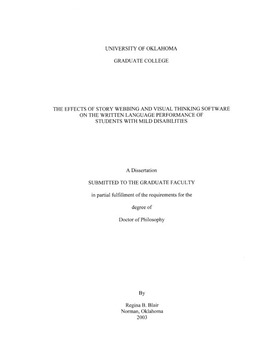| dc.contributor.advisor | Gardner, James E., | en_US |
| dc.contributor.author | Blair, Regina B. | en_US |
| dc.date.accessioned | 2013-08-16T12:19:00Z | |
| dc.date.available | 2013-08-16T12:19:00Z | |
| dc.date.issued | 2003 | en_US |
| dc.identifier.uri | https://hdl.handle.net/11244/619 | |
| dc.description.abstract | A total of eighteen seventh and eighth graders, identified by their school district as having mild disabilities, participated in this four week study. Students were rank ordered and alternately assigned to the intervention or comparison group. The research design for this study included the evaluation of five writing samples for each student: two handwritten samples and three word-processed samples. The independent variables were story webbing which was generated by hand or Inspiration and no story webbing. The dependent variables were the spontaneous subtests, composite scores, and quotient scores from the Test of Written Language 3rd edition ( TOWL-3): T-unit counts; word counts; character counts; Student Attitudes Survey, Student Interview Questionnaire and daily Instructors' Observation Logs. MANOVA were conducted to analyze the statistical data. | en_US |
| dc.description.abstract | The primary purpose of this mixed method quasi-experimental research was to examine the effects of teaching students with mild disabilities to use story webbing and visual thinking software. Changes in the quality and the quantity of students' writing, attitudes of students regarding the writing process, computer usage, and writing strategies, and as well as observed changes in student behavior and writing performance were explored. | en_US |
| dc.description.abstract | It is the conclusion of this study, that, because writing performance improved for both groups of students, having students write every day, giving them positive experiences with the writing process, and daily technology usage is probably the most practical solution for teachers from a pragmatic context. In this sense, the focus moves away from considering story webbing via technology in and of itself, to considering it one of many strategies which students perceive as a positive and useful support in the writing process. | en_US |
| dc.description.abstract | The results of the study indicate that there were consistent increases in the quality of writing of students in the intervention group whether products were handwritten or word processed. Increases were also found in the writing quality of students in the comparison group; however, while statistically significant differences were found when products were word processed, only minimal gains where present when products were handwritten. In addition the quantity of written language performance was shown to increase significantly between pretest and posttest for word processed products, yet little to no increase in the quantity handwritten was evident with either group when their writing samples were compared. Student attitudes regarding the writing process, computer usage and writing strategies were shown to improve when they were taught story webbing and visual thinking software. Positive changes in behavior and writing performance were observed by instructors within the study. | en_US |
| dc.format.extent | xiv, 189 leaves : | en_US |
| dc.subject | Children with disabilities Education (Middle school) | en_US |
| dc.subject | Composition (Language arts) Study and teaching (Middle school) | en_US |
| dc.subject | Education, Technology of. | en_US |
| dc.subject | Composition (Language arts) Computer-assisted instruction. | en_US |
| dc.subject | Education, Special. | en_US |
| dc.title | The effects of story webbing and visual thinking software on the written language performance of students with mild disabilities. | en_US |
| dc.type | Thesis | en_US |
| dc.thesis.degree | Ph.D. | en_US |
| dc.thesis.degreeDiscipline | Department of Educational Psychology | en_US |
| dc.note | Adviser: James E. Gardner. | en_US |
| dc.note | Source: Dissertation Abstracts International, Volume: 64-06, Section: A, page: 2039. | en_US |
| ou.identifier | (UMI)AAI3093587 | en_US |
| ou.group | Jeannine Rainbolt College of Education::Department of Educational Psychology | |
